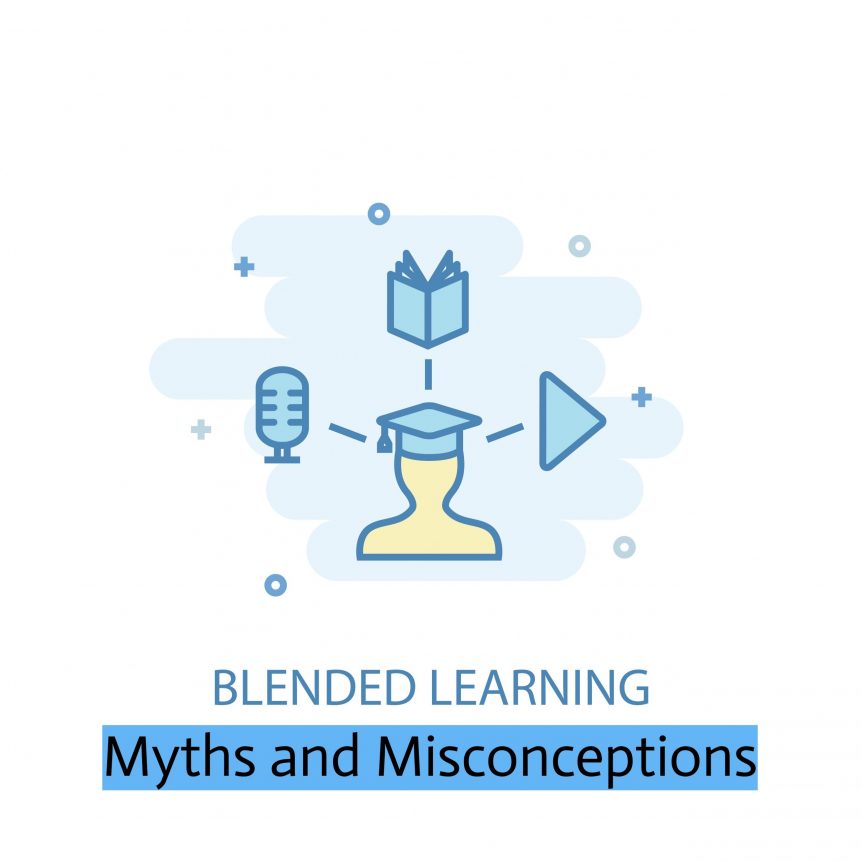7 Myths and Misconceptions About Blended Learning
When used correctly, blended learning is a highly effective strategy that achieves excellent returns on investment, delivers great learning outcomes, and maximises the learning experience.
However, it is a training strategy that is often misunderstood. Below, we debunk seven of the most common blended learning myths and misconceptions.
Myth 1: Blended Learning Costs More than Other Forms of Training
There is often a misconception that blended learning will be expensive because of the cost of developing the online learning elements and because devices will have to be provided to learners. The reality, however, is that online training often costs less than instructor-led training, not least because there is a reduced need for travelling and time away from other tasks.
In relation to devices, most companies that use e-learning or blended learning adopt a BYOD approach – bring your own device. In other words, the online learning content they create can be completed on any device, making it possible for learners to use their phones, a tablet device, a laptop, or a computer.
Furthermore, blended learning can save money in your training budget in other ways. For example, you will need less (if any) printed materials, as you can provide everything digitally, plus updating course content is a much easier and quicker process.
Fact: blended learning is often less costly, and it delivers significant returns on investment.
Myth 2: There is Only Type of Blended Learning Approach
You can actually construct your blended learning content and course in any way that you like. More specifically, in a way that will deliver the best results and help you achieve your learning objectives.In fact, there are seven different types of blended learning that you can use, making it a training strategy that is highly flexible and adaptable.
Fact: you can fully customise the way you structure your blended learning course.
Myth 3: Blended Learning Means People Learn Alone
Another incorrect assumption that some people have in relation to blended learning is that it involves a lot of learning in isolation, where learners substitute the interactivity of instructor-led sessions for content on a screen
While this might be the case for some blended learning courses, it is not a feature of blended learning. The reality is that one of the biggest benefits of blended learning is that it makes collaborative and social learning even more possible than other training delivery methods.
For example, for course topics and content that will benefit from collaborative or social learning experiences, these parts of the course can occur during the instructor-led or supported sessions.
Fact: blended learning facilitates and even encourages collaborative and social learning as well as teamwork
Myth 4: It is Difficult to Personalise Blended Learning
One of the objectives that many organisations have when implementing e-learning is to personalise the learning experience as much as possible. By personalising the learning experience, you can improve engagement and outcomes while also achieving your training goals. For some people, therefore, using blended learning feels like a step backwards.
This doesn’t have to be the case, however. As with many of the myths on this list, it all comes down to how you structure and develop the course and content.
For example, the online elements can be personalised just as you can with a full e-learning course. In addition, the instructor-led elements don’t have to involve an instructor leading a group learning session. Instead, it can be an instructor making themselves available for one-on-one support, help, and advice.
Fact: you can still personalise the learning experience using blended learning while benefiting from its other advantages.
Myth 5: Blended Learning is Simply About Delivering Some Content Online and Some Offline
Good blended learning courses are more about how you use each element to complement, supplement, or support other elements and the course overall. So, it’s not about just picking some content to be offline and some to be online. Instead, it involves thinking about how everything comes together, how everything is interlinked, and the structure of the learning journey.
Fact: blended learning involves careful planning to ensure online and offline elements interlink and complement each other.
Myth 6: Blended Learning Must Include Face-to-Face Instruction
When you use blended learning, you don’t need to include classroom training where each member of your team attends your Saudi or UAE office for part of the training. In other words, the offline parts of the course don’t have to be face-to-face. They don’t even have to be offline.
Instead, they can be virtual, and they don’t even have to be planned, i.e., the offline parts of the course can be available to learners on an ad hoc basis as and when they need it.
The crucial aspect of offline elements is that they are instructor-led. That can be in a physical classroom, but it doesn’t have to be.
Fact: blended learning involves e-learning content and instructor-led elements, not online and classroom content.
Myth 7: Blending Learning is a Stepping-Stone to Full Online Learning
Blended learning can be used to help your team transition from traditional methods of training delivery to e-learning, but this is not the primary purpose or benefit. Instead, it is a strategy on its own that can be beneficial whether you already use e-learning or not.
Fact: blended learning is a standalone training strategy that can be effective in many circumstances.
Key Takeaway – Flexibility
One of the main takeaways from the myth debunking and facts above is the flexibility of blended learning. It can be adapted in countless ways according to your requirements, objectives, and the topic of the training. This is a big part of what makes it such a successful training strategy.
